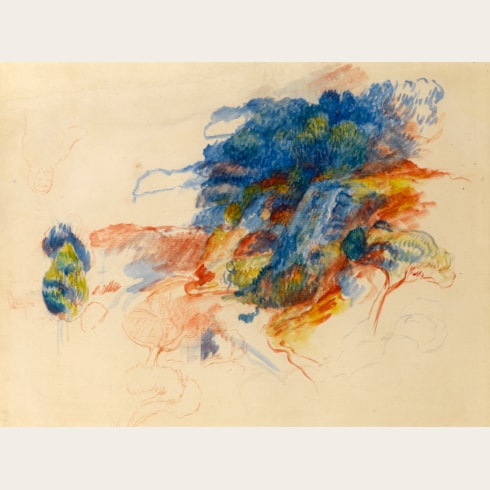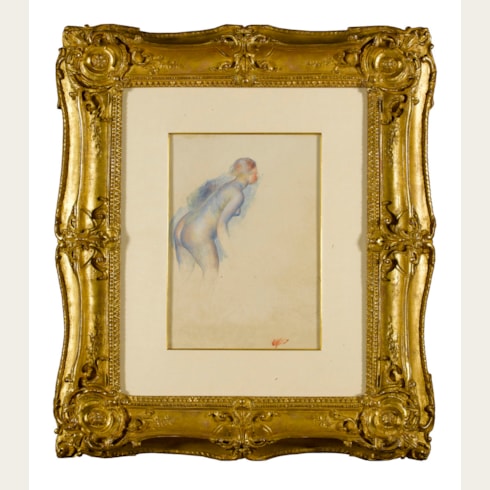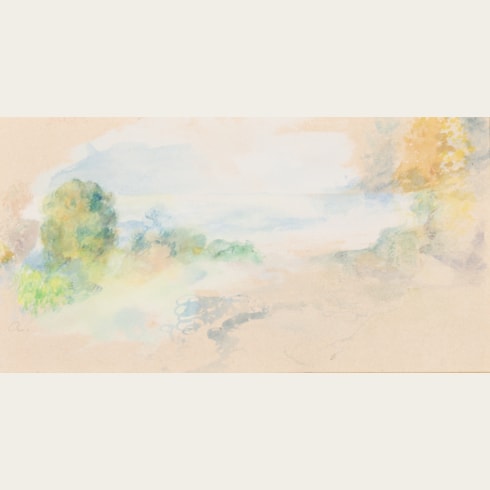Pierre Auguste RENOIR
(Limoges 1841 - Cagnes-sur-Mer 1919)
Portrait of Jeanne Samary (Fille au corset bleu) (Une blonde aux yeux bleus, vue de trois quarts sun un fond jaune)
Signed Renoir in blue chalk at the lower left.
610 x 444 mm. (24 x 17 1/2 in.)
Similarly, as Christine Ekelhart has noted of Renoir as a portraitist, 'He preferred to use pastels, consciously referring to the tradition of the eighteenth century, a time when pastels enjoyed a flowering in France, particularly in portraiture. Emphatic painterly qualities and an extreme close-up perspective lend these portraits a strong immediate presence, creating a direct relationship to the viewer.'
While he seems to have regarded his chalk drawings and watercolours as exercises towards his oil paintings, Renoir saw his pastels are finished works of art in their own right. At his first one-man show, held at the gallery of La Vie Moderne in 1879, the artist showed mainly pastels, including a number of portraits.
This pastel portrait is thought to depict Jeanne Samary, a popular and successful actress at the Comédie-Francaise who was one of Renoir's favourite models in the late 1870s. Léontine Pauline Jeanne Samary (1857-1890), joined the Comédie-Française at the age of eighteen, and soon achieved a level of celebrity underlined by the writer and theatrical director Jules Claretie's description of her as 'the muse of the Comédie; she had the smile of Marivaux, the imagination of Regnard, the wit of Molière, she was a star of contemporary art.'
Jeanne Samary lived with her parents on the rue Frochot, just a few metres from Renoir's studio on the rue Saint-Georges, until 1880. Renoir painted around a dozen portraits of Samary, in both oil and pastel, notably a full-length oil portrait, painted in 1878, now in the collection of the Hermitage in St. Petersburg. After her marriage in 1880, however, Renoir seems to have largely stopped painting Samary, whose attentions were now devoted to such painters as Carolus-Duran and Jacques-Emile Blanche.
Two other pastel portraits of Jeanne Samary by Renoir are known; one which was sold at auction in London in 1990 and the other formerly with the 20th century Parisian art dealer Etienne Bignou.
Auguste Renoir was an inveterate draughtsman, equally adept in pencil, pen, chalk, charcoal, watercolour and pastel. Yet he seems to have thought little of his drawings, throwing away or destroying most of them, and is said to have even used drawings to light the kitchen stove. Apart from pastels, Renoir only rarely exhibited his drawings in his lifetime, and it was not until two years after his death that a significant exhibition of his drawings was held, at the Galerie Durand-Ruel in 1921. The exhibition comprised a large number of drawings, watercolours and pastels from all periods of the artist’s career, numbering almost 150 works. For many visitors, the exhibition was a revelation; as one critic wrote, ‘We make our way into the artist’s studio, he opens his portfolios for us, hides nothing from us, from the most accomplished works to the faintest of notes.’
For much of the last two decades of his life Renoir’s hands were crippled by arthritis, so that by around 1913 his hands were so bent that he was no longer able to draw. Yet it remains true of Renoir that, as François Daulte wrote, ‘It is in his sketches and studies, rather than his large paintings, that he reveals all his originality and freshness of vision.’
Provenance
Literature









